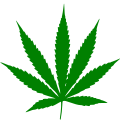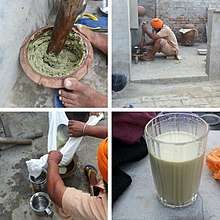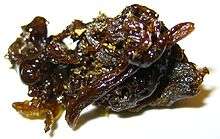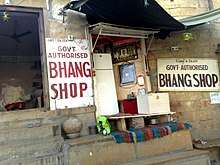Cannabis edible
A cannabis edible, also known as a cannabis-infused food or simply an edible, is a food product that contains cannabinoids, especially tetrahydrocannabinol (THC).[1] Although edible may refer to either a food or a drink, a cannabis-infused drink may be referred to more specifically as a liquid edible or drinkable.
| Part of a series on |
| Cannabis |
|---|
 |
|
|
|
|
Regional
|
|
Variants |
|
Most edibles contain a significant amount of THC, which can induce a wide range of effects, including relaxation, euphoria, increased appetite, fatigue, and anxiety.[2] THC-dominant edibles are consumed for recreational and medical purposes.[3] Some edibles contain a negligible amount of THC and are instead dominant in other cannabinoids, most commonly cannabidiol (CBD).[4] These edibles are primarily used for medical purposes only.[4]
Foods and beverages made from non-psychoactive cannabis products are known as hemp foods.[5]
History
.jpg) Bhang eaters from India c. 1790. Bhang is an edible preparation of cannabis native to the Indian subcontinent. It has been used in food and drink as early as 1000 BCE by Hindus in ancient India.[6]
Bhang eaters from India c. 1790. Bhang is an edible preparation of cannabis native to the Indian subcontinent. It has been used in food and drink as early as 1000 BCE by Hindus in ancient India.[6]
 Modern interest in edibles is attributed to Alice B. Toklas and her eponymous 1954 cookbook.
Modern interest in edibles is attributed to Alice B. Toklas and her eponymous 1954 cookbook.
The earliest recorded cannabis-infused food was in the Indian subcontinent, where people have prepared food and drink with bhang for millennia, for both spiritual and medicinal purposes.[8] The oil-solubility of cannabis extracts was also known to ancient Indians, with Sanskrit recipes requiring cannabis to be sautéed in ghee before mixing it with other ingredients.[9]:7[10]
Bhang has been used in food and drink as early as 1,000 BCE by Hindus in the Indian subcontinent.[11] Bhang is traditionally distributed during the Hindu spring festival of Holi.[12][13]
Modern interest in cannabis-infused food is credited to the publication of The Alice B. Toklas Cook Book. Toklas included a recipe for "haschich fudge", which was contributed by artist and friend Brion Gysin when the book was published in 1954. Although it was omitted from the first American editions, Toklas' name and her "brownies" became synonymous with cannabis in the growing 1960s counterculture.[14]
In some U.S. states that have legalized cannabis, edibles have experienced a dramatic rise in sales.[15] However, there is growing concern about the danger edibles pose to children and inexperienced cannabis consumers,[16] who may easily ingest too much at once, possibly not even realizing the food has been infused.[17][18] Furthermore, calls to poison control have dramatically increased since 2008 due to dogs ingesting edibles.[19] In Canada, cannabis-infused food products will be legal in October 2019, but regulatory restrictions and reduced consumer interest may inhibit innovation.[20]
Chemistry and pharmacology
Cannabis does not naturally contain significant amounts of THC. Rather, it contains high levels of tetrahydrocannabinolic acid (THCA), which converts into THC through decarboxylation, a process induced by heating.[21]
Comparing effects of eating cannabis products and smoking them is difficult because there are large margins of error due to variability in how different people smoke, with the number, duration, and spacing of puffs, the hold time and the volume of the person's lungs all affecting the dosing. With regard to eating, different vehicles in which cannabinoids are dissolved for oral intake affect the availability of the cannabinoids, and different people metabolize differently.[22] Generally, however, because oral doses are processed by the digestive system and the liver before entering the bloodstream, cannabinoids that are ingested are absorbed more slowly and have delayed and lower peak concentrations, and are cleared more slowly, compared to inhaling them in the aerosol that is formed when cannabis is burnt.[22] Oral administration generally leads to two peaks of concentration, due to enterohepatic circulation.[22]
Consuming THC through ingestion results in absorption through the liver and, through metabolic processes, the conversion of a significant proportion of it into 11-Hydroxy-THC.[22]
Types
Baked good


A cannabis-infused baked good is a common type of cannabis edible, which may include hash cookies, brownies, and "space cakes" (image). One may not be able to distinguish between regular baked goods and those containing cannabinoids which tend to have a slightly green tinge and often emit a faint cannabis smell. A mild grassy or cannabis flavor might be detectable if sufficient cannabis quantities are used.[9]:7
Drink
A cannabis-infused drink, also known as a liquid edible or drinkable, is a drink that contains cannabinoids, especially THC.
Traditional cannabis-infused drinks such as lassi and thandai, when prepared with bhang, originate from the Indian subcontinent.
In U.S. states that have legalized cannabis for recreational use, drinks were about 4% of the cannabis market in 2014 but had fallen to around 1.5% of the market in 2016.[23][24] Cannabis infused drinks can come in the form of sodas, teas, brews, and many more.
Capsule

A capsule containing THC or CBD that is not sold as a regulated pharmaceutical is also considered an edible and provides the same effect as food and drink.[25]
Ingredients
 Bottle of cannabis tincture
Bottle of cannabis tincture One form of hash oil
One form of hash oil Making cannabutter
Making cannabutter
Tincture
Cannabis tincture is an extract of cannabis contained in oil at room temperature. Generally, stems and leaves of the cannabis plant are used as source material because they contain high amounts of cannabinoids and are undesirable to smoke. When infused in high-proof grain-based alcohol, such as Everclear, the tincture becomes what is commonly known as green dragon. Creme de Gras (a play on the English "grass", as creme de gras translates literally as "cream of fat") is a flavored liqueur made from cannabis.[9]:31 It can be added to coffee and other beverages.
Oil
Cannabis oil is a product based in cooking oil that has been infused with cannabinoids by mixing cannabis with the heated oil. Cannabis cooking oils are available to medical cannabis patients in a variety of blends for various cooking applications.[26]
See also
References
- "Drug Alert: Marijuana Edibles". JustThinkTwice.gov. Retrieved October 20, 2017.
- "What are marijuana effects?". DrugAbuse.gov. Retrieved October 20, 2017.
- Crombie, Noelle. "Oregon's recreational marijuana market expands to edibles and extracts starting Thursday". OregonLive.com. Retrieved October 20, 2017.
- Terps, Tyler. "10 Little-Known Uses for CBD Oil". HighTimes.com. Retrieved October 20, 2017.
- Pierre Bouloc (16 September 2013). Hemp: Industrial Production and Uses. CABI. pp. 229–. ISBN 978-1-84593-793-5.
- Staelens, Stefanie. "The Bhang Lassi Is How Hindus Drink Themselves High for Shiva". Vice.com. Retrieved August 10, 2017.
- Ayyagari S (2007). ""Hori Hai": A Festival of Colours!! (review)". Asian Music. Johns Hopkins University Press. 38 (2): 151–153. doi:10.1353/amu.2007.0029.
- Staelens, Stefanie. "The Bhang Lassi Is How Hindus Drink Themselves High for Shiva". Vice.com. Retrieved August 10, 2017.
- Gottlieb, Adam (1993). Cooking with Cannabis: The Most Effective Methods of Preparing Food and Drink with Marijuana, Hashish, and Hash Oil. Ronin Publishing. ISBN 0-914171-55-0.
- Drake, Bill (2002). The Marijuana Food Handbook. Ronin Publishing. p. 18. ISBN 0-914171-99-2.
- Staelens, Stefanie. "The Bhang Lassi Is How Hindus Drink Themselves High for Shiva". Vice.com. Retrieved August 10, 2017.
- "Right kick for day-long masti". Times of India. Retrieved 17 March 2014.
- "Holi 2014: Festival Of Colors Celebrates Spring (SONGS, PHOTOS)". Huffington Post. Retrieved 17 March 2014.
- Eplatt, Layla (April 20, 2015). "Go Ask Alice: The History of Toklas' Legendary Hashish Fudge". Scientific American. Retrieved 22 September 2016.
- Lacsamana, Pauline. "Edible Marijuana Sales Continue to Rise, With Gummies and Mints Topping Sales". TheDailyMeal.com. Retrieved August 10, 2017.
- "The Buzz without the High: Checkout this Popular Cannabis Trend in 2019". New England Leaf. Retrieved 2019-08-28.
- "The rise of legal weed in America". TheWeek.com. Retrieved August 10, 2017.
- "Edible marijuana: What we need to know". TheConversation.com. Retrieved October 20, 2017.
- ByTara MahadevanChicago-based journalist // @mhdvn (2019-02-25). "People Keep Calling Poison Control After Their Dogs Eat Edibles". Complex. Retrieved 2019-10-28.
- Emma Davie (9 May 2019). "Canadians' enthusiasm wanes for legal pot and edibles, study finds". CBC News. Retrieved 11 May 2019.
- "What Is Decarboxylation, and Why Does Your Cannabis Need It?". Leafly. 2016-04-30. Retrieved 2019-08-28.
- Huestis, MA (2005). "Pharmacokinetics and metabolism of the plant cannabinoids, delta9-tetrahydrocannabinol, cannabidiol and cannabinol". Handbook of experimental pharmacology (168): 657–90. doi:10.1007/3-540-26573-2_23. PMID 16596792.
- Borchardt, Debra (June 29, 2016). "Marijuana Drinks Not Causing a Buzz". Forbes.
- "Company Introduces Marijuana Soda". ABC News. 2011-01-29. Retrieved 2017-07-28.
- "The Best Types of Edibles". High Times. 2018-06-03. Retrieved 2018-06-18.
- "Cooking With Cannabis | New Haven Independent". New Haven Independent. 2017-07-25. Retrieved 2017-07-28.
- Noelle Carter (20 April 2018). "Happy 4/20! Celebrate with homemade canna-butter". Los Angeles Times. Retrieved 18 November 2019.
External links
| Wikibooks Cookbook has a recipe/module on |
- The Straight Dope column on Alice B. Toklas brownies (includes original text of recipe)
- Beyond brownies: Cannabis chefs elevate edibles recipes. San Francisco Chronicle. 2018-10-09.
